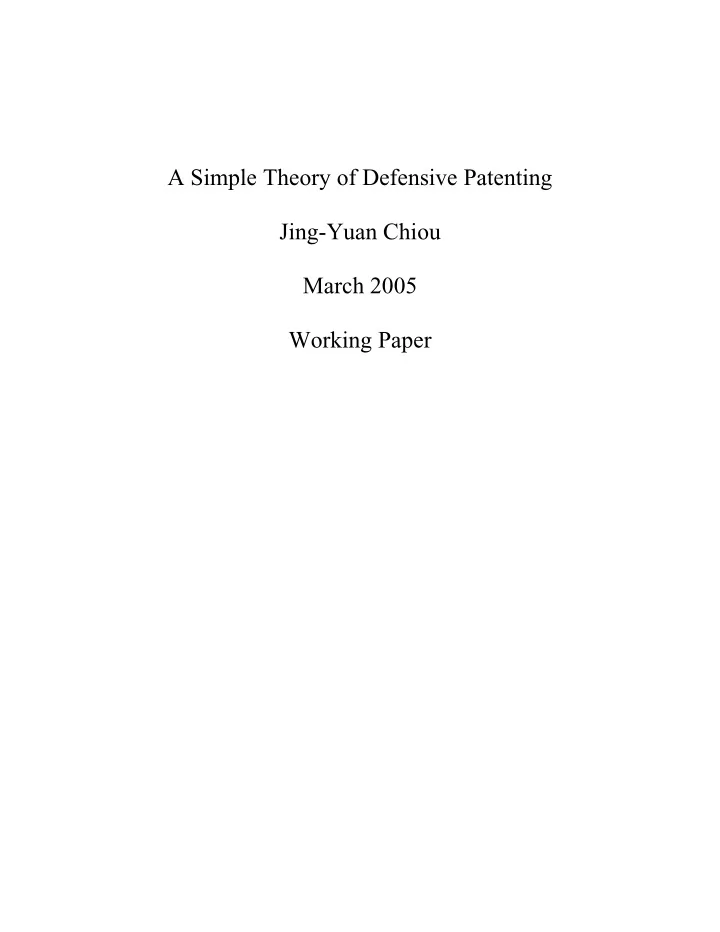

A Simple Theory of Defensive Patenting Jing-Yuan Chiou March 2005 Working Paper
Patent System as an incentive scheme Rewards are indirect, and are realized only under credible threat of enforcement The role of Defensive Patents: threat of counter-suit Usefulness of Defensive Patents is dependent on: Technology Structures � Presence of “complex technologies” � No single firm can develop all technologies necessary � Access to other firms’ technologies is necessary � Patents display “fuzzy boundaries” Legal Structures: CAFC and USPTO � Patentable subjects expanded � Patent validity more frequently backed by court � Patent holder power increased by grants of injunction � Allowance of seemingly low quality patents in recent years Result: Easier to gain patents and easier to infringe upon them Possible resultant strategy: Accumulation of Defensive Patents
Empirical Findings: � A surge in the patent propensities of Semi-Conductor Firms since 1980 : likely due to the shift towards pro- patent policies and a desire to protect very large investment costs and shield against large licensing fees (Hall, Ziedonis 2001) � Patent Litigation in Technology Sectors 1978-1999 : Infringement suits are less likely against large firms and firms with large patent portfolios, which increases the power to attack and defend. (Lanjouw and Schankerman 2003) � Computer and Research Medicine Patent Suits in Federal Courts 1983-1993 : In most cases where a suit came with a counter suit, the two claims were disposed within one day of each other – leads to a strong strategic effect of counter suits.
� � � � � � � � � � � � � � � � � � � � � � � � � The Model: F and F hold technologies A and Two identical firms A 1 2 1 2 eligible for patent protection. p at cost Decisions: whether to apply for patent K 0 , i e at cost whether to invest 0 , and - given a patent - c i whether to enforce. Occurs at t = -2, -1, and 0 respectively p i e , 0 , 1 Defines for i 1 , 2 i 1 , p Defines patent profile P � p and investment profile 2 1 , e E � e 2 No tech transfer is necessary Firms can be found liable only if the invest Courts grant permanent injunctive relief, and patents do not expire If suit is brought, firms incur legal expense with 0 L probability of patentee F prevailing is , ( 0 , 1 ] i 1 , 2 i and 1 2 Beginning at t = 0 , revenues accrue to firms according to the investment profile F , ˆ e Value streams are v that accrues to that accrues to ˆ v e 1 e e 1 2 2 1 ˆ F , which defines the joint value stream ˆ ˆ V v v 2 e e e e e e 1 2 1 2 2 1 V This defines discounted present values and v e i e e i e j j Firms may bargain for a licenses and cross-licenses at different stages of the game Ex-post efficiencies require that established investment be fully utilized (Nash Equilibrium with equal bargaining power).
� � � Enforcement and the Truce Equilibrium: The model defines either zero, one or two relevant patents that are eligible for suit. Author finds that if firms build patent portfolios with equal power, and if enforcement costs are strictly positive, there exists the possibility of a “truce equilibrium”. Proposition 1: Litigation Deterrence and the Truce Equilibrium Consider the enforcement stage when . A war P � E 1 , 1 equilibrium always exists, in which both firms initiate an infringement attack at the earliest possible date. However, if the delay between the suit and expected counter-suit is small enough, there exists a Pareto dominant sub-game perfect equilibrium without any litigation. The symmetric strategy is: do not sue if one has not yet been sued, and if one has been sued, immediately bring a counter-suit. Corollary: when the truce equilibrium prevails, there exists no litigation when either there is no patents or when both firms patent, and one infringement suit when one firm holds a patent and the other invests.
Hold-up and Strategic Patenting Conclusion: Defensive patenting can indeed alleviate the hold-up problem of patent threats Proposition 2: Patents can transform investment decisions into strategic substitutes into strategic complements, but not the other way around. Patenting Proposition 3: If firms invest with or without the presence of patents, and if patents can deter litigation (the truce equilibrium), then patenting decisions are strategic complements.
Primary Results: Due to the binary choice of firms, to determine the strategic properties of patent decisions, a comparison is made between the benefit of an offensive patent (i.e. when the other firm does not have one) and a defensive patent (when the other firm does). Strategic complementary occurs when the defensive patent has greater benefit. In general offensive patents prevent the other firm from investing, while defensive patents restore these incentives. The truce equilibrium implies no enforcement, so no licensing income is earned from holding a patent. Therefore the litigation deterrence of defensive patents can have a detrimental effect on the very purposes of a patent system. This leads to the paradoxical outcome that a strong pro-patent national policy can, in fact, decrease the incentives to innovate. Therefore, Firms may rush to the patent office, but no one actually benefits from holding patents.
Incorporating Recent Literature: Unique characteristics about the model: � Multiple patent holders and multiple enforcement options as opposed to single patent holder and an infringing firm. � Allows for a Truce Equilibrium. � Multi-stage game with investment and patent protection avenues as well as positive cost associated with each. � Infringers pay license fees rather than leave the market
Recommend
More recommend